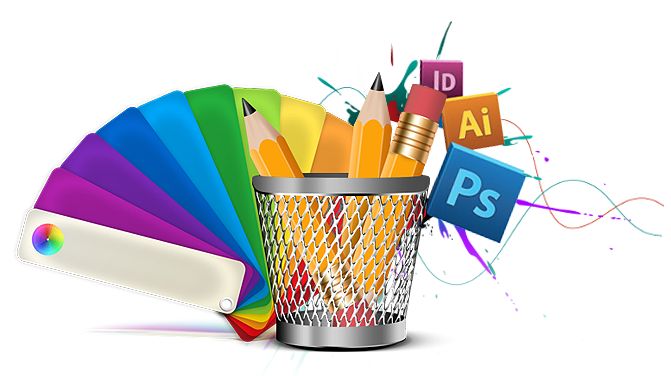
Graphic design is more than just creating visuals; it’s an art of communication. Whether you’re designing logos, posters, or social media graphics, understanding the core principles of graphic design can elevate your creative work to a professional level. By mastering these fundamentals, beginners can create designs that are not just visually appealing but also functional and purposeful.
Understanding Graphic Design Basics
At its core, graphic design involves the use of text, images, and colors to convey a message. This can be in the form of branding, advertisements, or digital content. To master the fundamentals, start with a solid understanding of design principles like:
- Balance: Ensuring all design elements are visually stable.
- Contrast: Making important elements stand out.
- Alignment: Organizing components for a polished look.
- Repetition: Creating consistency and unity in designs.
These principles guide designers to structure their work logically while appealing to their target audience.
Essential Tools and Software
To truly master graphic design, you must familiarize yourself with essential tools. Programs like Adobe Photoshop, Illustrator, and Canva are popular choices. While professional software offers robust features, beginners often find user-friendly tools helpful in learning the ropes.
Additionally, understanding the functionalities of these tools can help aspiring designers develop strong foundational skills. Many graphic design courses fees vary based on the software and resources they provide, making it easier for individuals to choose a program suited to their needs and budget.
Typography: The Art of Text Design
Typography plays a vital role in graphic design. Fonts, text alignment, and spacing all contribute to making your message clear and attractive. By experimenting with typefaces, you can determine which style aligns best with your project.
For instance, sans-serif fonts like Arial are clean and modern, while serif fonts such as Times New Roman lend a more formal and traditional feel. Combining these wisely ensures readability and professionalism.
Color Theory: Creating Emotional Impact
Colors have a powerful effect on emotions and perceptions. Understanding color theory helps designers create mood and brand consistency. Start by familiarizing yourself with concepts such as complementary, analogous, and monochromatic color schemes.
For example:
- Use warm colors like red and orange for excitement and energy.
- Opt for cooler shades like blue and green for calmness and trustworthiness.
Experimenting with colors allows you to define the mood of your designs and create a lasting impact on your audience.
Exploring Different Design Styles
Graphic design offers a multitude of styles that cater to diverse industries and tastes. From minimalism to vintage aesthetics, experimenting with various design styles helps you expand your creative abilities.
Beginners often start by replicating existing designs for practice. This exercise hones their skills and helps them discover unique preferences as they transition from following trends to setting them.
Creating User-Centered Designs
One key aspect of mastering graphic design is focusing on user experience. Whether it’s a website layout or an advertisement, your design should prioritize clarity and usability.
This involves:
- Simplifying navigation in digital content.
- Designing with accessibility in mind.
- Keeping the target audience’s preferences at the forefront.
For example, consider mobile users when designing responsive layouts. By creating user-centered designs, you ensure your work meets both aesthetic and functional goals.
The Importance of Feedback
Feedback is essential for growth in any creative field. Sharing your work with mentors, peers, or even online communities allows you to gain insights on how to improve. Constructive criticism highlights areas where your design may lack impact and helps you refine your skills over time.
Consider joining forums or social media groups where budding designers exchange ideas and seek guidance. This practice not only boosts confidence but also broadens your knowledge of industry trends.
Invest in Learning and Courses
Continuous learning is the key to excelling in graphic design. While practicing independently is valuable, enrolling in professional courses can provide structure and industry-relevant expertise.
Many graphic design courses fees are affordable and tailored to cater to various levels of expertise, from beginner to advanced. These courses typically include lessons on software mastery, design principles, and real-world projects, offering a well-rounded learning experience.
Online platforms and design academies often offer certifications that help budding designers stand out in the competitive job market. Investing in such courses is a step toward becoming a proficient and confident graphic designer.
Career Opportunities in Graphic Design
Graphic design opens doors to numerous career paths. Some of the popular roles in this field include:
- Brand Designer: Crafting the visual identity for companies.
- Web Designer: Focusing on websites and user experiences.
- Packaging Designer: Creating packaging that grabs attention.
- Advertising Designer: Producing visuals for campaigns.
With increasing demand for creative professionals, skilled graphic designers are crucial for businesses looking to make a strong visual impact.
Tips for Aspiring Designers
- Build a Portfolio: Showcase your best work in a clean and organized format.
- Stay Updated: Follow industry trends and update your skills regularly.
- Experiment: Push creative boundaries by exploring different styles and mediums.
- Practice Consistently: The more you design, the better you become.
Conclusion
Mastering graphic design fundamentals is an exciting journey filled with creativity and growth. By understanding essential principles, practicing consistently, and investing in quality education, you can carve a successful career in this field. Whether you’re exploring personal projects or planning to join professional graphic design courses, the knowledge you gain will set you up for long-term success.





Leave a Reply